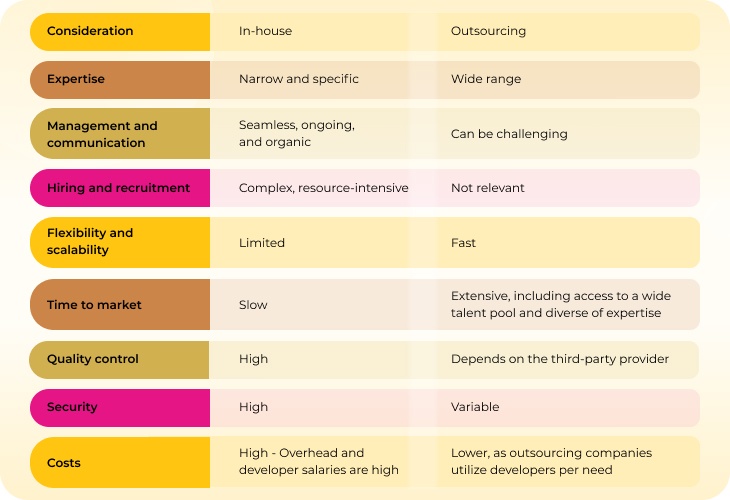So, you’ve got a fantastic idea for a new product to offer your clients, something that will really help you stand out from the competition, attract more business, and boost your bottom line. Now it’s time to turn the idea into reality, and the first step is often deciding between outsourcing the project or in-house development.
An in-house project usually means hiring full-time, salaried software development professionals to work directly under your company management, focusing on your product or products. Outsourcing means handing software development over to a third-party provider with the relevant skillset and domain know-how to design and implement your idea.
It isn’t a clear-cut decision—what works well for one business might be a disaster for another. This article breaks down the pros and cons of in-house software development so you can better understand what it entails for your business.
The pros of in-house software development

In-house custom software development has a lot of advantages, including the following.
Full control over the team and project
The best part of in-house software development is that you maintain complete control over everything related to the project. The product IP belongs to your business and you call the shots from A to Z, including timing, prioritization, monitoring progress, and ongoing quality control. Since you’re so involved, you know right away when something goes wrong and can fix it before things get too far off track.
Seamless communication
With an in-house development team, communication is ongoing. In many cases, you’re working in the same physical location, and even if you’re not, you’re using the same task management platform. Either way, you’re part of the same organizational culture, making it easier to communicate frequently and effectively. While that is a definite advantage, it can also have some drawbacks. For example, if the development team needs to run every decision through management, it can slow their progress down and limit the team’s freedom and creativity.
Quick bug fixes after deployment
Something goes wrong after you launch your new product? No worries, your in-house development team is at your service to fix the problem. There is no concern that they’ve moved on to the next project and don’t have time to focus on your needs, something that can happen with outsourcing companies that don’t have a dedicated customer support team.
Instill company values throughout the project
Most businesses have a unique organizational “DNA” that differentiates them from their competitors. When development is in-house, that unique DNA and company values come through in every aspect of the project.
Keep the know-how within the company
You’re developing this project as a differentiator, something to help you stand out from your competitors. With in-house software development, you keep that knowledge and the final product in your hands, maintaining your competitive advantage. You also have an expert team with a deep understanding of your business, which can be very helpful for future projects.
The cons of in-house software development

Now that we’ve covered the advantages, let’s look at the disadvantages of in-house software development.
Time intensive
One thing that many businesses don’t have is a lot of spare time on their hands. Software development takes time, both from the developers themselves and from management. That is time taken away from your core activity, the things that pay the bills, and time you often can’t afford to spare.
Monopolizes significant resources
Even with the best developers on your team, software development has a tendency to monopolize resources, from office space to cloud infrastructure to management time. When those resources are directed at software development, they aren’t being used elsewhere.
High costs
Experienced developers don’t come cheap, so hiring the professionals you need to do the job right is going to come with a price tag. And it’s not the developers alone. With in-house software development, you need to buy the infrastructure to support their work, including servers, cloud infrastructure, licenses, and more.
Difficulty scaling
In-house development doesn’t give you a lot of flexibility. If you encounter a market opportunity that requires scaling fast, it isn’t always easy to onboard extra developers quickly to take advantage of the opportunity. Furthermore, technology changes so quickly that the in-house expertise you develop for one project may not be relevant for the next one.
Slow time to market
Recruiting the right people, hiring them, waiting for them to complete their prior commitments, onboarding them, and training them for the specifics of your project takes time. Plus, in-house teams are generally small, which means they can’t move forward as fast as the larger teams offered by outsourcing companies. That means that it will take time to get your product to market, even in the best-case scenario.
How do companies develop software in-house?
If you’ve weighed the plusses and minuses decided on the in-house route, we’ve created a list of what you need to do to get started.
1. Hire a hiring expert
The first thing you need to do is hire a team. Since software development projects require specific types of expertise and people with those skill sets are in short supply, that means working with someone who can recruit the right people for your needs. In other words, you need a hiring expert to hire a software expert.
2. Create a proficiency exam
Once you have a hiring expert on board, the next step is to create a test to assess the proficiency of your applicants. A technical proficiency exam will give you a better understanding of the applicants’ skills than any interview can and will save you the time of interviewing candidates who don’t have the relevant know-how. Make sure that the exam isn’t too long—you don’t want to take advantage of the applicants by taking up their time before you’ve made a commitment to hire. We recommend an exam that takes no more than 2-3 hours to complete.
3. Decide on inbound or outbound recruitment
Your proficiency exam is ready, and now it’s time to select a recruitment strategy, choosing between inbound and outbound recruitment. Inbound recruitment focuses on creating a compelling employer brand and building a talent pipeline of candidates interested in working for your business.
Outbound recruitment is a more proactive approach where recruiters actively seek out and approach potential candidates, often through methods like cold calling, email outreach, or social media messaging. Outbound recruitment is particularly useful when you have specific roles to fill and are looking for candidates with specific skill sets or types of experience, as is often the case with software development.
4. Screen resumes & conduct interviews
Once people have begun applying for the positions you advertised, your hiring team will need to review the applicants’ resumes and set up interviews with the most qualified candidates. You may want to involve senior staff in the final round of interviews.
5. Make offers
You’ve completed the interview process, done due diligence, and spoken with references. Now it’s time to start making offers. You should decide ahead of time what, if any, flexibility you have regarding salary and benefits so you’ll be prepared and ready to move fast. Experienced developers are often considering more than one offer in parallel, so the faster you can move, the better.
6. Form your team
With the right people on board, it’s time to turn them into a team and get them as excited about your vision as you are. Team-building activities can be helpful in this stage, in addition to training and standard onboarding activities.
Outsourcing vs. in-house development comparison
Sometimes it can help to do a side-by-side comparison when weighing the pros and cons of in-house versus outsourcing software development.

In-house development could be the way to go
At the end of the day, the decision between in-house and outsourced software development really depends on your specific needs and the resources you have available.
For example, if your business regularly handles sensitive client data or requires stringent security measures, in-house development may be the right choice. In-house software development gives you greater control over your clients’ data, which may give you a competitive advantage with certain types of clients. Another scenario in which in-house could be preferable is if you’re planning to implement several software development projects in the near future.
As always, remember that InTandem’s white-label solutions are yet another option, giving you a set of tools to offer your clients and a competitive advantage without the challenges of in-house development or outsourcing.


























